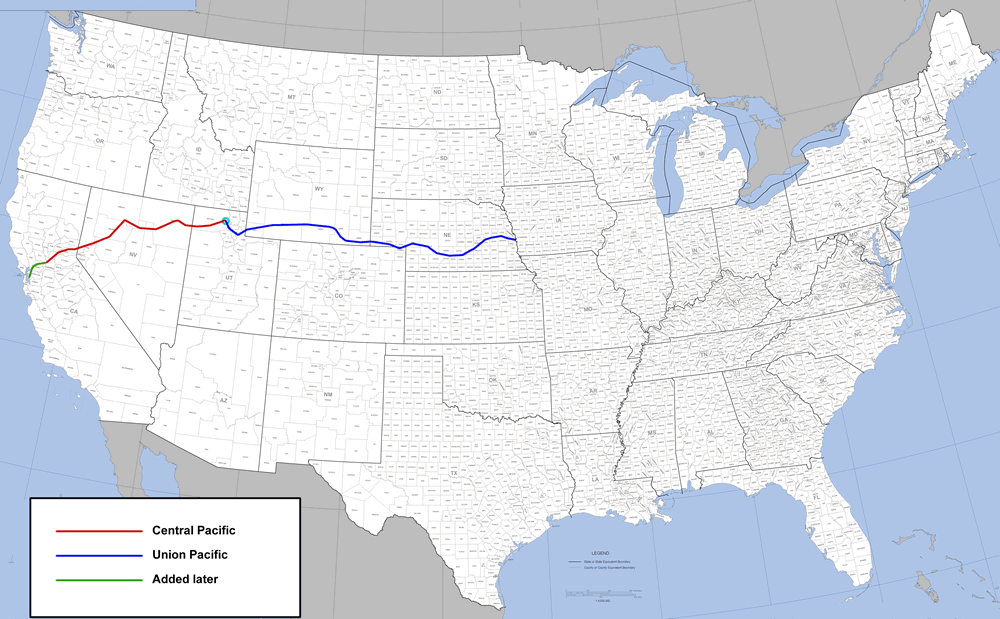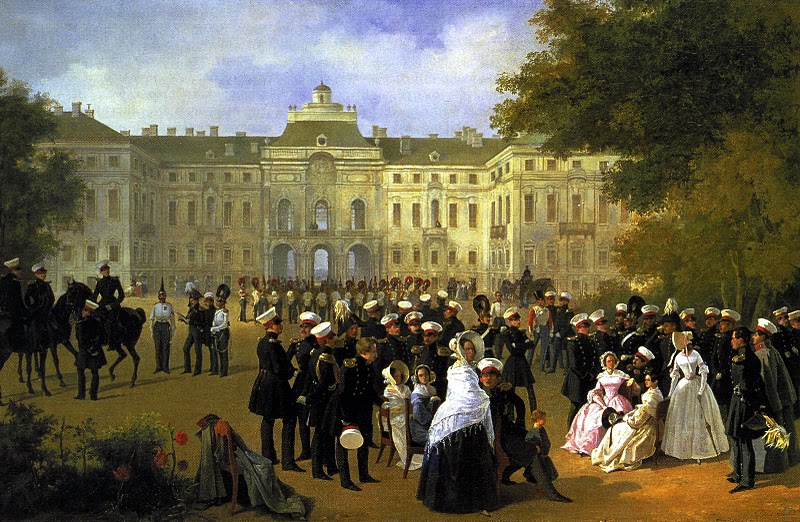|
Natalia Pushkina
Natalia Nikolayevna Pushkina-Lanskaya (russian: link=no, Наталья Николаевна Пушкина-Ланская; 8 September 1812 – 26 November 1863) ( Goncharova) (Гончарова), was the wife of the Russian poet Alexander Pushkin from 1831 until his death in 1837 in a duel with Georges d'Anthès. Natalia was married to Major-General Petr Petrovich Lanskoy from 1844 until her death in 1863. Prior to marriage Natalia (Natalya) Goncharova was born on 8 September 1812 (27 August 1812 Old Style) in Karian village in Tambov Governorate (in present-day Znamensky District, Tambov Oblast), where her family lived during the occupation of Moscow by the forces of Napoleon. Her father, Nikolay Afanasievich Goncharov, a scion of the family of paper manufacturers from Kaluga, was pronounced demented in 1815; the household was managed by his wife, Natalia Ivanovna Zagriajskaya, an imperious lady with connections within Muscovite nobility. Her ancestors included Petro D ... [...More Info...] [...Related Items...] OR: [Wikipedia] [Google] [Baidu] |
Tambov Governorate
Tambov Governorate was an administrative unit of the Russian Empire, Russian Republic, and later the Russian SFSR, centred around the city of Tambov. The governorate was located between 51°14' and 55°6' north and between 38°9' and 43°38' east. It bordered Vladimir Governorate and Nizhny Novgorod Governorate to north, Penza Governorate and Saratov Governorate to the east, Voronezh Governorate to south and west, and Oryol Governorate, Tula Governorate, and Ryazan Governorate to the west. History The governorate was created in 1796 when it was reformed out of Tambov Viceroyalty ('' namestnichestvo'') that was organized in 1779. The borders of it were unchanged until 1926 when the northern half of the governorate was split between other two governorates of Penza and Ryazan. Due to the administrative reform of 1928 Tambov governorate was divided into three okrugs: Tambov Okrug, Kozlov Okrug, and Borisoglebsk Okrug. In 1937 a substantial part of the governorate was transformed ... [...More Info...] [...Related Items...] OR: [Wikipedia] [Google] [Baidu] |
Great Ascension Church
The Greater Church of Christ's Ascension (Большое Вознесение) is one of the largest parish churches in downtown Moscow. It is a major landmark of Bolshaya Nikitskaya Street and Nikitskiye Vorota Square. It is named "greater" to prevent confusion with a nearby church of the same name. The church was commissioned by Prince Potemkin, the owner of a neighbouring messuage, shortly before his death. The yellow-colored Neoclassical building was erected between 1798 and 1816. The name of the architect is not known for certain. It has been attributed either to Matvey Kazakov, who built numerous Moscow churches in the reign of Catherine the Great, or Ivan Starov, who frequently worked for Potemkin. The edifice was overhauled to Osip Bove's designs after the 1812 Fire of Moscow. It stood unfinished for several decades and was not completed (under Afanasy Grigoriev's supervision) until 1848. The church holds historical significance for several reasons. It was in this chur ... [...More Info...] [...Related Items...] OR: [Wikipedia] [Google] [Baidu] |
Russian Nobility
The Russian nobility (russian: дворянство ''dvoryanstvo'') originated in the 14th century. In 1914 it consisted of approximately 1,900,000 members (about 1.1% of the population) in the Russian Empire. Up until the February Revolution of 1917, the noble estates staffed most of the Russian government and possessed a Gentry assembly. The Russian word for nobility, ''dvoryanstvo'' (), derives from Slavonic ''dvor'' (двор), meaning the court of a prince or duke ('' kniaz''), and later, of the tsar or emperor. Here, ''dvor'' originally referred to servants at the estate of an aristocrat. In the late 16th and early 17th centuries, the system of hierarchy was a system of seniority known as '' mestnichestvo''. The word ''dvoryane'' described the highest rank of gentry, who performed duties at the royal court, lived in it (''Moskovskie zhiltsy''), or were candidates to it, as for many boyar scions (''dvorovye deti boyarskie'', ''vybornye deti boyarskie''). A nobleman ... [...More Info...] [...Related Items...] OR: [Wikipedia] [Google] [Baidu] |
People From Tambovsky Uyezd
A person ( : people) is a being that has certain capacities or attributes such as reason, morality, consciousness or self-consciousness, and being a part of a culturally established form of social relations such as kinship, ownership of property, or legal responsibility. The defining features of personhood and, consequently, what makes a person count as a person, differ widely among cultures and contexts. In addition to the question of personhood, of what makes a being count as a person to begin with, there are further questions about personal identity and self: both about what makes any particular person that particular person instead of another, and about what makes a person at one time the same person as they were or will be at another time despite any intervening changes. The plural form "people" is often used to refer to an entire nation or ethnic group (as in "a people"), and this was the original meaning of the word; it subsequently acquired its use as a plural form of p ... [...More Info...] [...Related Items...] OR: [Wikipedia] [Google] [Baidu] |
1863 Deaths
Events January–March * January 1 – Abraham Lincoln signs the Emancipation Proclamation during the third year of the American Civil War, making the abolition of slavery in the Confederate states an official war goal. It proclaims the freedom of 3.1 million of the nation's four million slaves and immediately frees 50,000 of them, with the rest freed as Union armies advance. * January 2 – Lucius Tar Painting Master Company (''Teerfarbenfabrik Meirter Lucius''), predecessor of Hoechst, as a worldwide chemical manufacturing brand, founded in a suburb of Frankfurt am Main, Germany. * January 4 – The New Apostolic Church, a Christian and chiliastic church, is established in Hamburg, Germany. * January 7 – In the Swiss canton of Ticino, the village of Bedretto is partly destroyed and 29 killed, by an avalanche. * January 8 ** The Yorkshire County Cricket Club is founded at the Adelphi Hotel, in Sheffield, England. ** American Civil War &nd ... [...More Info...] [...Related Items...] OR: [Wikipedia] [Google] [Baidu] |
1812 Births
Year 181 ( CLXXXI) was a common year starting on Sunday (link will display the full calendar) of the Julian calendar. At the time, it was known as the Year of the Consulship of Aurelius and Burrus (or, less frequently, year 934 ''Ab urbe condita''). The denomination 181 for this year has been used since the early medieval period, when the Anno Domini calendar era became the prevalent method in Europe for naming years. Events By place Roman Empire * Imperator Lucius Aurelius Commodus and Lucius Antistius Burrus become Roman Consuls. * The Antonine Wall is overrun by the Picts in Britannia (approximate date). Oceania * The volcano associated with Lake Taupō in New Zealand erupts, one of the largest on Earth in the last 5,000 years. The effects of this eruption are seen as far away as Rome and China. Births * April 2 – Xian of Han, Chinese emperor (d. 234) * Zhuge Liang, Chinese chancellor and regent (d. 234) Deaths * Aelius Aristides, Greek orator and w ... [...More Info...] [...Related Items...] OR: [Wikipedia] [Google] [Baidu] |
Strelna
Strelna ( rus, Стре́льна, p=ˈstrʲelʲnə) is a municipal settlement in Petrodvortsovy District of the federal city of Saint Petersburg, Russia, about halfway between Saint Petersburg proper and Petergof, and overlooking the shore of the Gulf of Finland. Population: History Strelna was first mentioned in Cadastral surveying of Vodskaya pyatina in 1500, as the ''village of Strelna on Retse Strelne on the Sea'' in the churchyard Kipen Koporsky County. After Treaty of Stolbovo these lands were part of Sweden, and in 1630 in Strelna appears as a baronial estate of Swedish politician Johan Skytte. The estate had a marina, a water mill, a pond, a greenhouse and a small house church. Palace of Peter the Great Formerly a Swedish chancellor's estate, Strelna was chosen by Peter the Great as a place for his future summer house in 1714. Jean Baptiste Le Blond, famous for his work with André Le Nôtre at Versailles, was commissioned to prepare designs for a palace and ... [...More Info...] [...Related Items...] OR: [Wikipedia] [Google] [Baidu] |
Nicholas I Of Russia
, house = Romanov-Holstein-Gottorp , father = Paul I of Russia , mother = Maria Feodorovna (Sophie Dorothea of Württemberg) , birth_date = , birth_place = Gatchina Palace, Gatchina, Russian Empire , death_date = , death_place = Winter Palace, Saint Petersburg, Russian Empire , burial_place = Peter and Paul Cathedral, St. Petersburg, Russian Empire , religion = Russian Orthodox , signature = Signatur Nikolaus I. (Russland).PNG Nicholas I , group=pron ( – ) was Emperor of Russia, King of Congress Poland and Grand Duke of Finland. He was the third son of Paul I and younger brother of his predecessor, Alexander I. Nicholas inherited his brother's throne despite the failed Decembrist revolt against him. He is mainly remembered in history as a reactionary whose controversial reign was marked by geographical expansion, economic growth, and massive industrialisation on the one hand, and centralisation of administrative policie ... [...More Info...] [...Related Items...] OR: [Wikipedia] [Google] [Baidu] |
Marina Tsvetaeva
Marina Ivanovna Tsvetaeva (russian: Марина Ивановна Цветаева, p=mɐˈrʲinə ɪˈvanəvnə tsvʲɪˈtaɪvə; 31 August 1941) was a Russian poet. Her work is considered among some of the greatest in twentieth century Russian literature."Tsvetaeva, Marina Ivanovna" ''Who's Who in the Twentieth Century''. Oxford University Press, 1999. She lived through and wrote of the Russian Revolution of 1917 and the Moscow famine that followed it. In an attempt to save her daughter Irina from starvation, she placed her in a state orphanage in 1919, where she died of hunger. Tsvetaeva left Russia in 1922 and lived with her family in increasing poverty in Paris, Berlin and Prague before returning to Moscow in 1939. Her husband Sergei Efron and their daughter Ariadna (Alya) were arrested on espionage charges in 1941; her husband was executed. Tsvetaeva committed suicide in 1941. As a lyrical poet, her passion and daring linguistic experimentation mark her as a striking chron ... [...More Info...] [...Related Items...] OR: [Wikipedia] [Google] [Baidu] |
Anna Akhmatova
Anna Andreyevna Gorenko rus, А́нна Андре́евна Горе́нко, p=ˈanːə ɐnˈdrʲe(j)ɪvnə ɡɐˈrʲɛnkə, a=Anna Andreyevna Gorenko.ru.oga, links=yes; uk, А́нна Андрі́ївна Горе́нко, Ánna Andríyivna Horénko, . ( – 5 March 1966), better known by the pen name Anna Akhmatova,. was one of the most significant Russian poets of 20th century. She was shortlisted for the Nobel Prize in 1965 and received second-most (three) nominations for the award the following year. Akhmatova's work ranges from short lyric poems to intricately structured cycles, such as ''Requiem'' (1935–40), her tragic masterpiece about the Stalinist terror. Her style, characterised by its economy and emotional restraint, was strikingly original and distinctive to her contemporaries. The strong and clear leading female voice struck a new chord in Russian poetry.Harrington (2006) p. 11 Her writing can be said to fall into two periods – the early work (1912–25) a ... [...More Info...] [...Related Items...] OR: [Wikipedia] [Google] [Baidu] |
Nikolaus Wilhelm Of Nassau
Prince Nikolaus Wilhelm of Nassau (20 September 1832 – 17 September 1905), was the only son of William, Duke of Nassau by his second wife Princess Pauline of Württemberg. Marriage and issue He married morganatically in London on 1 July 1868 with Natalia Alexandrovna Pushkina (Saint Petersburg, 4 June 1836 – Cannes, 23 March 1913). She was the youngest child of Alexander Sergeyevich Pushkin and his wife, Natalia Nikolayevna Goncharova, and a descendant of Abram Petrovich Gannibal and Petro Doroshenko, Hetman of Ukrainian Cossacks, in turn grandson of Mykhailo Doroshenko. She was divorced from Russian General Mikhail Leontievich von Dubelt, by whom she had a daughter. In 1868, Prince Nikolaus Wilhelm's sister Princess Helena of Nassau's husband George Victor, Prince of Waldeck and Pyrmont granted Natalia the title Countess von Merenberg. They had three children: * Countess Sophie von Merenberg (Geneva, 1 June 1868 – London, 14 September 1927); created Countess de Torby in ... [...More Info...] [...Related Items...] OR: [Wikipedia] [Google] [Baidu] |

_1938.jpg)




